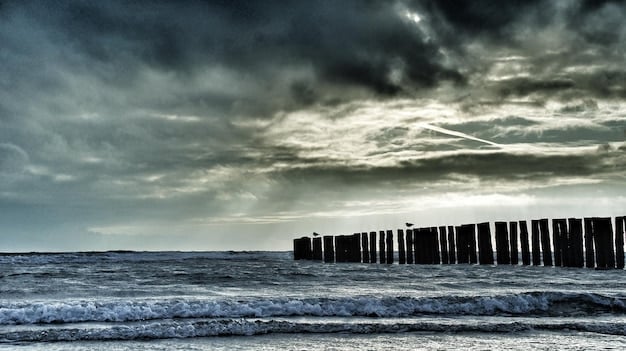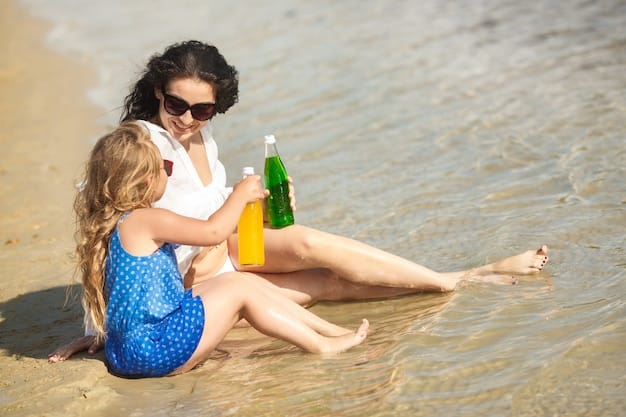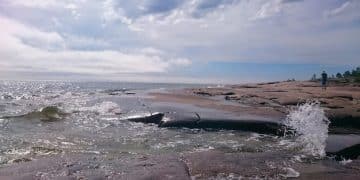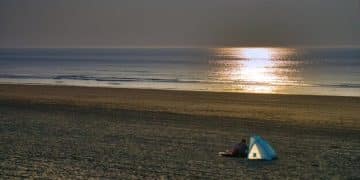7 Overlooked Beach Safety Tips That Could Save Your Life in 2025

Navigating coastal waters requires awareness beyond basic swimming, with 7 overlooked beach safety tips that could save your life in 2025, including understanding rip currents and wildlife, checking weather patterns, practicing sun protection, maintaining hydration, recognizing medical emergencies, and staying informed about local conditions.
As 2025 approaches, many of us eagerly anticipate beach getaways, drawn by the allure of sun-kissed sands and rhythmic waves. However, behind the idyllic facade lie inherent dangers that are often underestimated. This article delves into 7 overlooked beach safety tips that could save your life in 2025, urging a proactive approach to coastal leisure. Understanding these less-talked-about precautions can transform a potential hazard into a truly relaxing escape.
Understanding the Hidden Dangers of Rip Currents and Undertows
Rip currents and undertows are perhaps the most deceptive of all beach hazards. Many beachgoers mistake a rip current for a good place to swim because the water often appears calmer than the surrounding waves. This visual trick can be fatal, pulling even strong swimmers away from shore quickly and efficiently.
A rip current is a powerful channel of water flowing rapidly away from the shore, often appearing as a gap in breaking waves, a line of foam, or discolored water moving seaward. Undertows, while often conflated with rip currents, are a different phenomenon – a receding wave’s strong pull along the bottom, usually less dangerous but still capable of causing a swimmer to lose their footing.
Spotting a Rip Current Before It’s Too Late
Learning to identify a rip current is a critical first step in beach safety. It takes practice and observation, but understanding the visual cues can make all the difference. Look for areas where waves aren’t breaking, or where there’s a channel of choppy, churning water pushing seaward.
- Gap in Waves: A noticeable break in the pattern of incoming waves.
- Foam and Debris: A line of foam, seaweed, or debris moving steadily out to sea.
- Discolored Water: A patch of water differing in color from the surrounding water, often murkier due to sand being churned up.
- Turbulent Water: Choppy, agitated water beyond the surf zone, where the current is strongest.
If caught in a rip current, the primary advice is to remain calm, conserve energy, and avoid swimming directly against the current. Instead, swim parallel to the shore until you are out of the current’s pull, then swim back to shore. If unable to escape, float and wave for help. This crucial knowledge is often overlooked, with many instinctively trying to fight the current, leading to exhaustion and panic.
Remember, the ocean is a powerful force, and fighting against it is rarely the solution. Respecting its power and understanding its dynamics are fundamental to safe beach enjoyment. Always pay attention to lifeguard warnings and beach flags, which often indicate the presence of dangerous currents.
Navigating Unpredictable Weather Patterns and Tides
The weather at the beach can change dramatically in a short period, transforming a sunny day into a perilous storm. Many beachgoers check the general forecast but fail to consider localized weather phenomena or the often-underestimated power of tides. These elements combined can create unexpected hazards, from sudden downpours to rapidly advancing water lines.
Paying close attention to microclimates and specific coastal weather warnings is crucial. A sunny sky at home doesn’t guarantee a pleasant day at the beach, especially when sea breezes can dramatically affect temperatures and cloud cover. Monitoring conditions minute-by-minute can prevent a simple day out from becoming a dangerous situation.
Critical Weather and Tidal Monitoring
Beyond checking a basic weather app, it’s vital to seek out specialized marine forecasts. These often provide more detailed information about wind speeds, wave heights, and the likelihood of sudden storms, elements that greatly impact beach safety. Understanding tidal charts is equally important, particularly for those exploring tide pools or secluded coves that can become cut off at high tide.
- Marine Forecasts: Consult specialized weather services for coastal areas, which provide critical details on wind, wave action, and storm potential.
- Tidal Charts: Know the local high and low tide times. This is especially important for exploring coastal caves, tide pools, or remote areas that might become submerged.
- Sudden Storms: Be aware of increasing cloud cover, changes in wind direction, or distant thunder. Lightning can strike beaches, and sudden downpours can reduce visibility.
- Changing Wind Conditions: Offshore winds can make it difficult for swimmers, paddleboarders, or kayakers to return to shore.

Ignoring these factors can lead to being caught far from safety during a storm, or worse, trapped by an incoming tide. The dynamic interplay between wind, waves, and tides can create dangerous conditions even on seemingly calm days. Always err on the side of caution and be prepared to pack up quickly if conditions begin to deteriorate. Your vigilance in monitoring these natural forces is a key component of a safe beach experience.
Wildlife Encounters: Respecting Marine Life Boundaries
Many beachgoers are captivated by the thought of seeing marine life, from playful dolphins to unique tide pool creatures. However, this fascination often leads to a lack of understanding or respect for these animals and their habitats. Unintentional disturbances or aggressive approaches can not only harm the wildlife but also put humans at risk, turning a magical encounter into a dangerous one.
It’s important to remember that beaches are shared spaces, and for many species, they are their natural homes. Approaching wildlife with caution and maintaining a respectful distance is paramount. This simple act of consideration can prevent defensive reactions from animals and helps preserve the delicate balance of coastal ecosystems.
Understanding and Avoiding Dangerous Interactions
While most marine animals are not inherently aggressive towards humans, they will defend themselves if they feel threatened. This can range from a sting from a jellyfish or stingray to a bite from a shark or sea lion. Knowing how to react if an encounter occurs, and more importantly, how to prevent it, is a vital, yet often overlooked, beach safety tip.
- Jellyfish & Stingrays: Scan the water before entering and shuffle your feet when walking in shallow areas to scare away stingrays. If stung, seek immediate medical attention or apply vinegar for jellyfish stings (not all jellyfish stings respond to vinegar, some species require hot water).
- Sharks: Avoid swimming at dusk or dawn, in murky water, or near fishing boats. Do not wear shiny jewelry. If a shark is spotted, exit the water calmly and quickly.
- Seals & Sea Lions: Maintain a respectful distance. Do not feed them or attempt to pet them, as they can deliver painful bites.
- Birds & Other Animals: Do not feed them human food, which can disrupt their natural diets and make them reliant on humans.
Educating oneself about the local marine life before visiting a beach is an excellent preventative measure. Many coastal areas have educational centers or signage detailing common species and safe viewing practices. By understanding and respecting the boundaries of marine life, we can ensure both our safety and the well-being of the ecosystem. It’s a mutual respect that guarantees harmony in shared natural spaces.
The Silent Threat of Sun Exposure and Dehydration
While the sun is undoubtedly one of the main draws of a beach vacation, its power is often drastically underestimated. Beyond a painful sunburn, excessive sun exposure and inadequate hydration can lead to severe health issues, including heatstroke, severe dehydration, and long-term skin damage. Many beachgoers prioritize aesthetics over protection, dismissing sunscreen reapplication or consistent water intake as nuisances.
The combination of direct sunlight, reflective sand, and sea breeze can intensify UV radiation, making the beach environment uniquely hazardous for sun exposure. Moreover, the cooling effect of the water can mask the body’s rising temperature, leading individuals to believe they are not as hot, or as dehydrated, as they truly are.
Proactive Measures Against Heat-Related Illnesses
Preventing the silent threats of sun exposure and dehydration requires a calculated and consistent approach. It’s not just about applying sunscreen once; it’s about a holistic strategy that includes protective gear, frequent reapplication, and constant hydration. These measures must be integrated into every beach trip, not treated as optional extras.
- Sunscreen Application & Reapplication: Use a broad-spectrum sunscreen with an SPF of 30 or higher and apply it generously 30 minutes before sun exposure. Reapply every two hours, or more frequently after swimming or sweating.
- Protective Clothing: Wear wide-brimmed hats, UV-protective clothing, and sunglasses to shield delicate skin and eyes.
- Seeking Shade: Utilize umbrellas, canopies, or natural shade, especially during peak sun hours (10 AM to 4 PM).
- Consistent Hydration: Drink plenty of water throughout the day, even if you don’t feel thirsty. Avoid excessive alcohol or sugary drinks, which can contribute to dehydration.

The consequences of neglecting these precautions can range from ruined vacations to serious medical emergencies. Prioritizing skin and body health through diligent sun protection and hydration ensures that your beach experience remains enjoyable and safe, protecting you from both immediate discomfort and long-term health risks. Make conscious choices that safeguard your well-being against the sun’s potent rays.
Recognizing and Responding to Medical Emergencies
Even with the best precautions, unforeseen medical emergencies can occur at the beach. From minor cuts and scrapes to more severe situations like allergic reactions, heatstroke, or sudden cardiac events, being prepared to recognize symptoms and respond appropriately is crucial. Many people tend to be in “vacation mode” and might overlook subtle signs of distress in themselves or others, assuming discomfort is just part of beach life.
The dynamic environment of a beach, often far from immediate medical facilities, makes quick and effective first aid even more important. Understanding basic first aid interventions and knowing when to call for professional help can significantly impact outcomes, turning a potentially catastrophic event into a manageable one.
Essential First Aid and Emergency Action Plans
Having a basic understanding of first aid and a plan for how to act in an emergency are invaluable assets at the beach. This includes knowing who to contact, how to provide immediate care, and how to stay calm under pressure. These skills are not just for trained professionals; they are capacities that every responsible beachgoer should cultivate.
- Basic First Aid Kit: Always carry a waterproof first aid kit stocked with essentials like bandages, antiseptic wipes, pain relievers, and any personal medications.
- Recognizing Heatstroke: Look for confusion, hot dry skin, rapid pulse, and loss of consciousness. Move the person to shade, cool them with water, and seek immediate medical help.
- Allergic Reactions: Be aware of signs like swelling, difficulty breathing, or hives. If an EpiPen is available and the person is having a severe reaction, administer it and call emergency services.
- CPR & AED Knowledge: Consider taking a CPR course. Knowing how to perform chest compressions can be life-saving in cases of sudden cardiac arrest. Be aware of AED locations if available at the beach.
Never hesitate to call for professional help if you suspect a serious medical emergency. Beach environments can be deceptively calm, but they often present unique challenges for emergency response. Your quick thinking and preparedness can make all the difference, providing critical aid until professional medical assistance arrives. Taking responsibility for medical preparedness ensures a safer environment for everyone.
The Importance of Local Knowledge and Warnings
Many beach visitors arrive, unfold their towels, and plunge into the ocean without a moment’s consideration for local conditions or warnings. This oversight can be a grave mistake. Coastal environments are highly dynamic, and what was safe yesterday might be hazardous today due to factors like recent storms, changes in currents, or ecological events such as red tides or jellyfish blooms.
Relying solely on a general understanding of beach safety is insufficient; local conditions add a critical layer of specific hazards that must be understood. Neglecting local information is akin to driving in an unfamiliar city without checking the traffic or road closures – dangerous and avoidable.
Seeking Out Local Insights and Heeding Warnings
Before even setting foot on the sand, make it a priority to consult local resources. This includes checking official beach websites, speaking with local residents or lifeguards, and paying close attention to any posted signage. These sources provide context-specific information that generic safety tips simply cannot offer, painting a complete picture of potential risks.
- Lifeguard Stations: Speak to lifeguards upon arrival. They are the best source of real-time information about currents, wave conditions, and any specific hazards.
- Information Boards: Read all posted signs, which often detail local risks, water quality, and environmental regulations.
- Local News & Apps: Check local news outlets or specific beach safety apps for updates on water conditions, marine life advisories, or weather alerts.
- Consult Locals: If possible, ask local residents about any unique dangers or best practices for the specific beach you are visiting.
Ignoring local knowledge isn’t just risky; it’s a missed opportunity to fully understand and respect the environment you’re entering. The insights gleaned from local sources are often the most crucial, as they account for the unique, often subtle, characteristics of a particular beach. Embracing this proactive approach ensures that you are not just visiting a beach, but truly engaging with it safely and responsibly.
Ensuring Children’s and Vulnerable Individuals’ Safety: Beyond Supervision
While direct supervision is undoubtedly the cornerstone of protecting children and vulnerable individuals at the beach, often there’s an over-reliance on this one factor. Effective safety extends far beyond simply “watching” them. This includes preparing them for potential scenarios, ensuring they have appropriate safety gear, and understanding their individual limitations in the dynamic beach environment. The illusion of constant supervision can be shattered in mere seconds.
Moreover, vulnerable individuals, such as the elderly or those with certain medical conditions, require tailored safety considerations. Their physical capabilities, reaction times, and tolerance to environmental stressors like heat or sun exposure might differ significantly, necessitating a more nuanced approach than general beach safety guidelines.
Comprehensive Safety Strategies for All Ages
A truly safe beach experience for children and vulnerable individuals requires a multi-layered strategy that anticipates challenges and provides proactive solutions. This involves education, appropriate safety gear, and establishing clear boundaries and communication. It’s about empowering them with safety knowledge while providing a protective framework.
- Designated Swim Zones: Encourage swimming in supervised areas and within designated swim zones. Clearly communicate boundaries to children.
- Life Vests & Floatation Devices: For non-swimmers or weak swimmers, ensure they wear U.S. Coast Guard-approved life vests when near or in the water.
- Buddy System: Implement a buddy system, especially for children or those who might become disoriented. Ensure everyone knows who their buddy is and stays together.
- Emergency Contact Information: For children, write contact information on their arm or a waterproof wristband in case they get separated. For vulnerable adults, ensure caregivers have emergency contacts readily available.
- Regular Check-ins: Establish a routine for regular check-ins, especially during crowded times or for those who might wander.
It’s vital to have frank conversations about potential dangers with children, tailored to their understanding, without instilling fear. For vulnerable adults, ensure their specific needs are met with dignity and foresight. By adopting a comprehensive, proactive strategy that goes beyond mere observation, you create a safer, more enjoyable beach experience for everyone, minimizing risks and maximizing peace of mind.
Sustainable Beach Practices: Protecting the Environment and Yourself
Often overlooked in the context of personal safety is the integral link between our actions and the health of the beach ecosystem. Practices that harm the environment, such as littering, disturbing natural habitats, or using non-biodegradable products, can indirectly pose risks to humans. For instance, discarded fishing lines can entangle swimmers, plastic debris can cause injuries, and disrupted ecosystems can lead to imbalances that affect water quality or marine life aggression.
A truly safe beach is a healthy beach. Adopting sustainable practices is not just an ethical choice; it’s a crucial component of personal safety, ensuring that the natural environment remains pristine and free from human-induced hazards. Our responsibility extends beyond ourselves to the very ecosystem we seek to enjoy.
Beyond “Leave No Trace”: Active Environmental Stewardship
Sustainable beach practices go beyond the simple “leave no trace” philosophy to active environmental stewardship. This involves conscious decisions and actions that support the ecological integrity of coastal areas, directly contributing to a safer and more enjoyable experience for everyone. It’s about being a participant in its preservation, not just a visitor.
- Waste Management: Always dispose of trash properly. Consider bringing a separate bag for recycling. Avoid leaving any food scraps, as they can attract unwanted wildlife.
- Protecting Dunes & Vegetation: Stay on designated paths. Dunes and coastal vegetation are vital for erosion control and act as habitats for wildlife. Disturbing them can lead to instability and ecosystem damage.
- Chemical-Free Products: Use reef-safe sunscreen and avoid bringing harsh chemicals to the beach. These can leach into the water, harming marine life and potentially swimmers.
- Mindful Recreation: Be aware of your surroundings during recreational activities. For instance, kiteboarding too close to swimmers or disturbing nesting birds can lead to accidents or harm to wildlife.
By consciously choosing to engage in sustainable beach practices, we contribute to a healthier environment that, in turn, enhances our own safety and enjoyment. A well-maintained and respected beach ecosystem is less likely to present unforeseen hazards, offering a more pristine and predictable environment for recreation. This mindful approach ensures that the beauty and safety of our beaches are preserved for generations to come, truly making them havens of relaxation.
| Key Safety Point | Brief Description |
|---|---|
| 🌊 Rip Current Awareness | Identify and escape rip currents by swimming parallel to shore, not against them. |
| ⛈️ Weather & Tide Checks | Consult marine forecasts and tidal charts to avoid sudden storms or entrapment. |
| 🦀 Respect Wildlife | Maintain distance from marine life and know how to react to stings/bites. |
| ☀️ Sun & Hydration | Apply and reapply sunscreen, seek shade, and drink plenty of water to prevent heat illness. |
Frequently Asked Questions About Beach Safety
Easily identify rip currents by looking for a channel of churning, choppy water, a line of foam or debris moving steadily out to sea, or a noticeable break in the incoming wave pattern. These indicators suggest a powerful outflow of water. Always observe the water carefully for several minutes before entering.
For jellyfish stings, rinse with vinegar (if available) or seawater and remove any tentacles. For stingray stings, immerse the affected area in hot water (as hot as tolerable) for 30-90 minutes to relieve pain. In both cases, monitor for allergic reactions and seek medical attention if symptoms worsen.
You should reapply broad-spectrum sunscreen with an SPF of 30 or higher every two hours, or even more frequently if you are swimming, sweating heavily, or towel drying. The reflective properties of sand and water intensify UV exposure, making consistent reapplication essential for effective protection.
Beyond supervision, ensure children wear U.S. Coast Guard-approved life vests if they are not strong swimmers. Establish clear swimming boundaries, utilize a buddy system, and write emergency contact information on them. Educate them on simple safety rules and the importance of staying within sight.
Checking local weather and tide charts is crucial because coastal conditions can change rapidly. Marine forecasts provide wind and wave details, while tide charts prevent getting trapped by incoming water or encountering strong currents. This local knowledge helps avoid unexpected hazards and ensures a safer beach experience.
Conclusion
As we anticipate future beach excursions in 2025, embracing these 7 overlooked beach safety tips that could save your life in 2025 is not just a recommendation but a vital commitment to personal well-being. From understanding the nuances of rip currents and respecting marine life to diligently monitoring weather conditions and prioritizing sun protection, each measure contributes to a holistic approach to safety. Prompt recognition of medical emergencies, adherence to local warnings, and thoughtful precautions for vulnerable individuals further enhance the beach experience, transforming potential dangers into opportunities for blissful relaxation. By integrating these critical, often-ignored, practices, beachgoers can ensure their coastal adventures are both unforgettable and undeniably safe.





